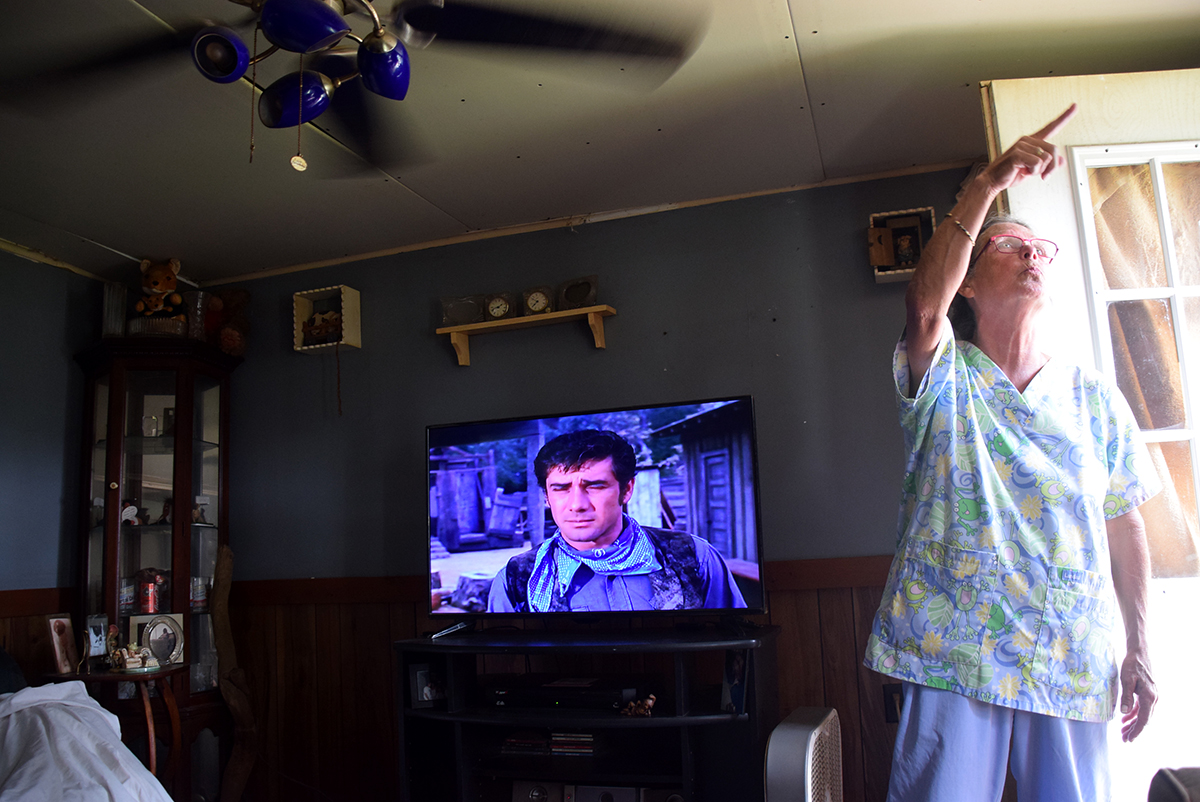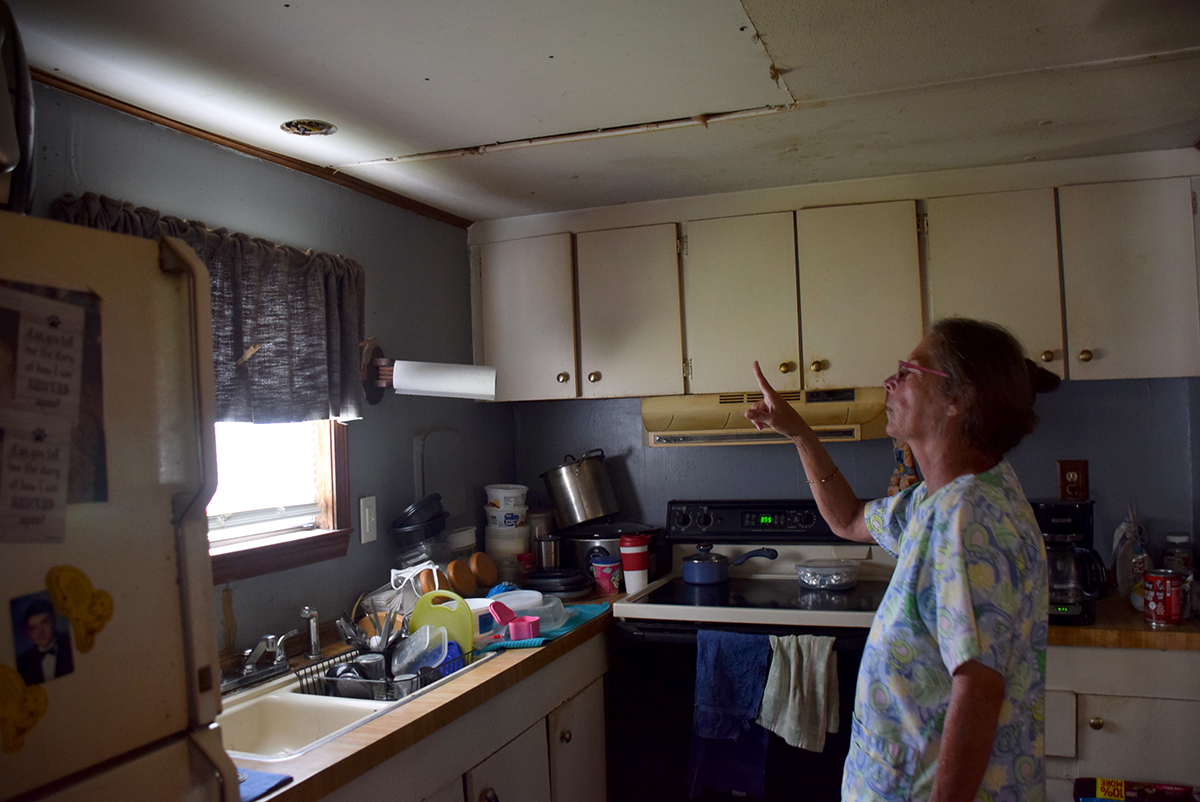
It’s been three years since Hurricane Florence and five years since Hurricane Matthew – both of which wreaked havoc in North Carolina, damaging or destroying homes and disrupting lives. Those whose homes were most severely damaged are in some cases still rebuilding. Others remain in limbo, waiting for promised assistance from the state.
Brenda Hite works as a certified nursing assistant and lives in an older mobile home close to Bogue Sound and Broad Creek in Carteret County. Florence destroyed her roof and days of rainfall associated with the storm poured into the home’s interior.
Despite repairs, conditions inside make the structure still partly uninhabitable, Hite said. Although the home has two bedrooms, she said unrepaired damage and a still-leaky roof force her to sleep in the living room, which, along with the adjoining kitchen, are the only rooms fit to occupy.
Hite applied in June 2020 to Rebuild NC, the state’s long-term disaster recovery program administered by the North Carolina Office of Recovery and Resiliency. A caseworker assessed her home and told her that she would qualify for a replacement home if she could show that damage from the storm totaled more than $5,000.
Hite told Coastal Review that she provided all the required documents possible, but she received no paperwork for partial repairs to her home performed by another state agency, NC STEP, or Sheltering and Temporary Essential Power, work she considers substandard and incomplete. NC STEP says it “provides basic, partial repairs to make homes safe, clean and secure to help North Carolina homeowners with minor damage from Hurricane Florence get back in their home quickly,” according to the agency’s website.
Getting receipts for the work was “like pulling teeth,” she said, and her caseworker told her in July of this year that should expect an award letter from Rebuild NC.
“I never got any paperwork of the work they’ve done — they did all theirs on iPads and tablets, so I didn’t receive not one piece of paper,” she said.
Then Hite’s case manager told her she had missed the deadline for documentation, but Hite said she had proof in the form of an email that she hadn’t missed the deadline.
Then in August, Hite received another notice that more documentation was needed.
Most recently, Hite said Rebuild NC told her again Oct. 7 that she should expect an award letter and a follow-up contact in the next 30 days to go over details and discuss floor plans and color choices for a modular home because of a shortage of mobile homes.
Hite continues to wait, but she remains skeptical.
“That’s what’s so frustrating about this,” she said. “I’m doing everything they’ve asked me to do and I don’t see that they’re doing anything for anybody. This is my second caseworker. The other one quit.”

Greg Dail of North Topsail Beach was also promised financial assistance based on his losses from Hurricane Florence.
“In fact, we were solicited to join the program,” Dail told Coastal Review in an email. “But no monies have been forthcoming, and from what I’m reading on social media, I’m not optimistic.”
Dail, 67, is retired and disabled as a result of rheumatoid arthritis, and his wife works as a nurse. He told Coastal Review in a phone interview that the storm blew the roof off their home.
“Our house was completely destroyed,” he said. “This was a very slow-moving storm, so it rained inside the house for about six hours.”
Dail said he had paid about $100,000 out of pocket for repairs. He said it shouldn’t take months or years to process these claims, even with the coronavirus pandemic.
“We have insurance. This put us in a financial hardship, but we recovered. The thing about it is, it’s just bureaucratic headaches, you know?” Dail said.
Like Hite, Dail has had caseworkers come and go. He thought the process was nearly complete, with all inspections and paperwork completed, and then a new caseworker contacted him.
“She said, ‘Well, we need to come out and inspect your house.’ Oh really?” Dail said.
“There are some people in dire need, a hell of a lot more need than me. I’ve got a roof over my head, and I will recover eventually — I hope. But the people who are in worse shape than I am are also still being strung along, and the frustration lies in — again — the process has just taken, way, way too long.”

Nearly all the dozen or so reviews posted on the Rebuild NC Facebook page echo Hite and Dail’s frustration.
“The exhausting application process and LENGTHY review (well over a year) turned out not to be worth my time,” Sara Jayne Anderson Cailler of Wallace posted on the agency’s social media page. “They strung us along for 15 months with countless requests for information, copies of multitudes of documents (sent multiple times because they claim they never got them), driving to their offices to deliver documents, more emails and phone calls than I care to count. Six (yes, SIX) different case managers throughout the process. Today we got notice that we are INELIGIBLE. If I had to do it all over again … I WOULDN’T. Very disappointing AND discouraging.”
Burgaw resident David Sandmeyer posted a similar review on the agency’s Facebook page: “We applied in July 2020 and have not received any updates. Our case worker rarely responds to our requests for updates and when she does it is always the same answer ‘It is under review.’”
Laura Hogshead, director of the North Carolina Office of Recovery and Resiliency, recently told Coastal Review that the agency had completed construction on 667 homes and has awarded more than $1.98 million to 2,274 applicants for long-term recovery from hurricanes Matthew and Florence. Rebuild NC is NCORR’s largest hurricane recovery program.
The agency’s Homeowner Recovery Program is funded through a federal Housing and Urban Development Community Development Block Grant Disaster Recovery Program, or CDBG-DR. The state program includes an eight-step process that follows HUD’s guidelines and requirements for the use of the federal funds for long-term housing recovery. The steps include application, eligibility review, duplication check, inspection and environmental review, grant determination, contractor selection, construction and completion.
The Homeowner Recovery Program has a budget of $150.84 million for those affected by Hurricane Matthew and $352.72 million for Hurricane Florence.
The funding is intended to be a last resort for residents with low-to-moderate income and to supplement, but not duplicate, funding received by other federal, state and local recovery assistance programs.
“Often, these homeowners need considerable time and assistance in gathering documentation, getting access to the deed on their homes, and catching up with property taxes in order to effectuate construction,” Hogshead said.
The state Office of Recovery and Resiliency employs state employees and contractors to staff the Homeowner Recovery Program. State employees lead the project management operations, which include housing program management and applicant services, as well as program delivery operations, such as construction oversight and delivery.
Case managers employed by vendors are supervised by state employees. Case managers are responsible for staffing ReBuild NC centers throughout the state, working one-on-one with applicants to ensure they understand the application process, their responsibilities, and the responsibilities of the program.
Case managers are to maintain regular contact with applicants and provide status updates on their cases, Hogshead said in an email response to questions.
“Once the applicant moves into the construction phase, each applicant is assigned a Construction Liaison. The Construction Liaison is in contact with the homeowner bi-weekly to check on progress, respond to questions or concerns and ensure proper construction coordination is taking place. The General Contractor assigned to the applicant’s project works with the Construction Liaison to keep the applicant apprised of progress,” she said.
Hogshead said all external contractors are to document progress, updates and interactions with applicants through a system called Salesforce, “and these logs are closely monitored in order to meet federal regulations and HUD standards.”
NCORR’s Project Management office and Program Delivery office manages the applicant’s progress through the eight steps of the project.
“NCORR has implemented timeliness milestones for our staff and vendor staff to follow, and these milestones are monitored consistently. That said, every homeowner’s path through the eight steps is dependent on that homeowner’s responsiveness and ability to provide required documentation and other factors, such as whether or not asbestos and lead are found in the home prior to construction,” Hogshead said.
The state is responsible for ensuring that applicants move through the eight steps as quickly as possible while being compliant with federal requirements, she added.
Timelines for individual cases vary because of factors including staff processing, construction estimates, material availability and applicant engagement.
Hogshead said it was important to note that each HUD grant, the one for Matthew and the one for Florence, is available for a minimum of six years. “Recently, recognizing the effects of the pandemic, HUD extended the Hurricane Matthew grant, which was awarded in 2017, for two full years. Additionally, HUD did not offer and sign a grant agreement with North Carolina for nearly two years after Hurricane Florence made landfall in N.C., meaning that the state could not begin recovery efforts until that grant was executed in June 2020. “
She said the pandemic had caused delays for Rebuild NC contractors in obtaining materials, and manufacturers have been unable to produce high volumes of manufactured housing units. “These circumstances are unfortunately out of the program’s control.”
The agency is working to identify solutions to the materials and labor shortages, she said, “but these delays are seen across the country in every CDBG-DR grantee program, as shown by HUD’s decision to extend the grants by two years.”
She encouraged applicants with questions to contact their construction liaison or the program’s construction hotline at 919-444-2761.
"wait" - Google News
October 21, 2021 at 11:00AM
https://ift.tt/2Z8TMWI
Homeowners wait for long-promised state hurricane relief | Coastal Review - Coastal Review Online
"wait" - Google News
https://ift.tt/35qAU4J
https://ift.tt/2Ssyayj
Bagikan Berita Ini














0 Response to "Homeowners wait for long-promised state hurricane relief | Coastal Review - Coastal Review Online"
Post a Comment